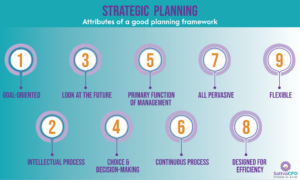Strategic Planning is the formula to a successful organization. The aspect is always misunderstood, but the motive isn’t. Every day, there is always a company that shuts down due to lack of a plan, and that plan is the strategy that they failed to play. This article tries to educate you of the basics of a strategic plan.
Table of Contents
What is Strategic Planning?
Strategic planning (SP) is when the heads of organizations decide their long-term vision and their organization’s goals and objectives. The method also includes determining how those goals should be achieved to achieve its stated vision. A strategic plan identifies who you are as a company and lays forth a roadmap for achieving your objectives. When the unexpected happens, a strategic plan can help your company survive and grow while staying true to its values and mission. Furthermore, developing a strategic plan is a team-building exercise that can bring people together. Also, articles discuss on definition and process of SP.
What is Strategic Plan?
The strategic strategy of the organization serves as the foundation for planning. It acts as a roadmap for the creation of sound sub-plans to achieve the organization’s goals. The goal of strategic planning is to assist a firm in selecting and organizing its businesses to keep the organization healthy even if the environment changes unexpectedly. In addition, it aims to reshape or reshape the company’s businesses and goods to achieve desired profits and growth.
What is Strategic Management?
Strategic management is a field of management concerned with an organization’s long-term goals. This could include creating the organization’s vision, defining its operational goals, and developing and implementing its strategy. If necessary, it may also have the creation and implementation of deviation corrective procedures. The strategic management process is not to be misunderstood with the organizational strategy, which is connected but not the same.
What is Strategic Execution?
Strategy execution results from a set of planned, enterprise-wide actions and decisions that occur in the process, rather than a single employee decision or action. It is, therefore, broad and must enlist the execution may begin at the top of the company, but it must trickle down in it to be successful.
What are the various ways to Strategic Planning?
Creating a strategic plan for your company or government agency doesn’t have to be a time-consuming and costly task. Instead, consider it a decision-making process that prevents you from making the same mistakes year in year out. In addition, your other decision-making tools, such as project appraisal and budget analysis, will benefit from a strategic plan. As a result, the better your strategy formulation is, the better your strategic management and execution will be.
When your strategic planning process – including decision analysis – includes decision-making frameworks for day-to-day execution, it is more effective. First, before the procedure commences, functional leaders must agree to maintain a strategic mentality and not allow a relatively brief, tactical action plan and other activities to hijack them. Concerns about attaining short-term goals, fear of failure, and a focus on operational challenges all too often trump aspiration. Functional leaders’ mission is to understand activities that will advance business growth aspirations and unlock the capacity to fuel them.
What is Strategic Map?
A strategy map is a visual representation of the elements of a company’s strategy and the links between financial, customer, internal process, and learning and growth perspectives. The notion illustrates how companies can use strategy maps as a vital tool in their planning and strategy efforts. It explains how companies have utilized strategy maps to establish strategy implementation and lays out the processes for putting the concept into practice.

What are the attributes of a Good Planning Framework?
- Goal-oriented.
- Look at the future.
- Intellectual Process.
- Choice & Decision-making.
- The primary function of management
- Continuous Process
- All Pervasive.
- Designed for Efficiency.
What is the process of Strategic Planning?
The steps in Strategic planning are:
-
Strategy formulation
The process of identifying the most suitable course of action to achieve the goals of the organization, and so fulfilling the strategic objectives, is referred to as strategy formulation.
-
Strategy Implementation
The translation of a decided strategy into organizational action to achieve strategic goals and objectives is known as strategy implementation. In addition, how a company should establish, utilize, and incorporate management structure, process control, and culture to follow strategies that result in competitive advantage and improved performance is also characterized as strategy implementation.
What are the benefits of Strategic Planning?
Strategic planning directs a company’s time, energy, and money, ensuring that resources are not wasted on unlikely projects to yield satisfactory outcomes. A firm and its employees can stay focused on specific goals and preserve a feeling of purpose by simplifying operations. Strategic planning has a wide range of benefits that affect management, employees, consumers, and other stakeholders.
What are the key elements of Strategic Planning?
The critical elements of SP are as follows:
- Vision
- Mission
- Objectives
- Strategy
- Approach
- Tactics
How can SattvaCFO help your entity in Strategic Planning?
SattvaCFO has been making the move in enhancing organizational goals ever since its inception. With a systematic study of the company and its people, SattvaCFO can help develop an SP that meets the corporate objectives, thus completing the needs and wants in a fast-growing world.
Please connect with SattvaCFO for preparing & executing of Strategic Plan.
Also read:




